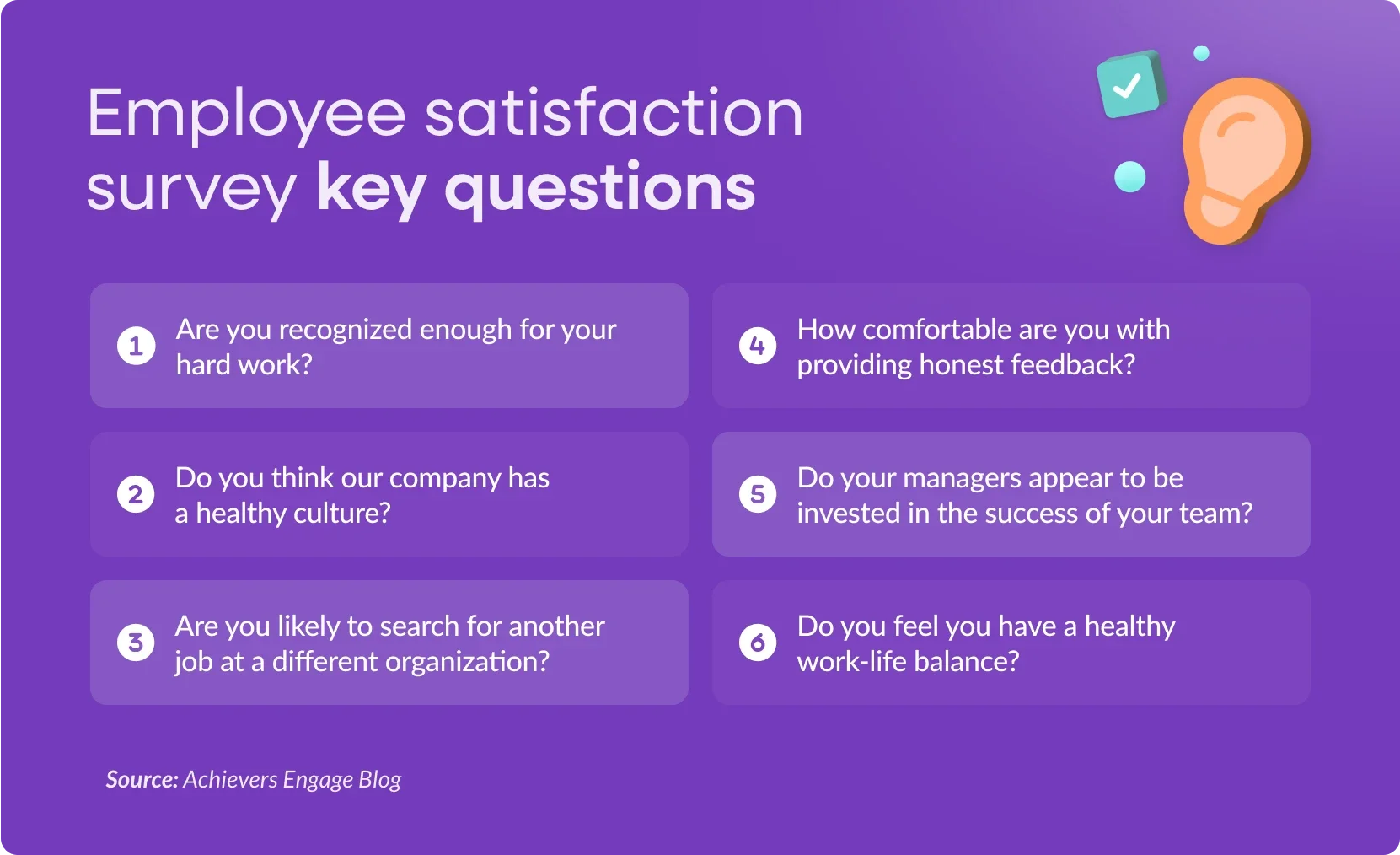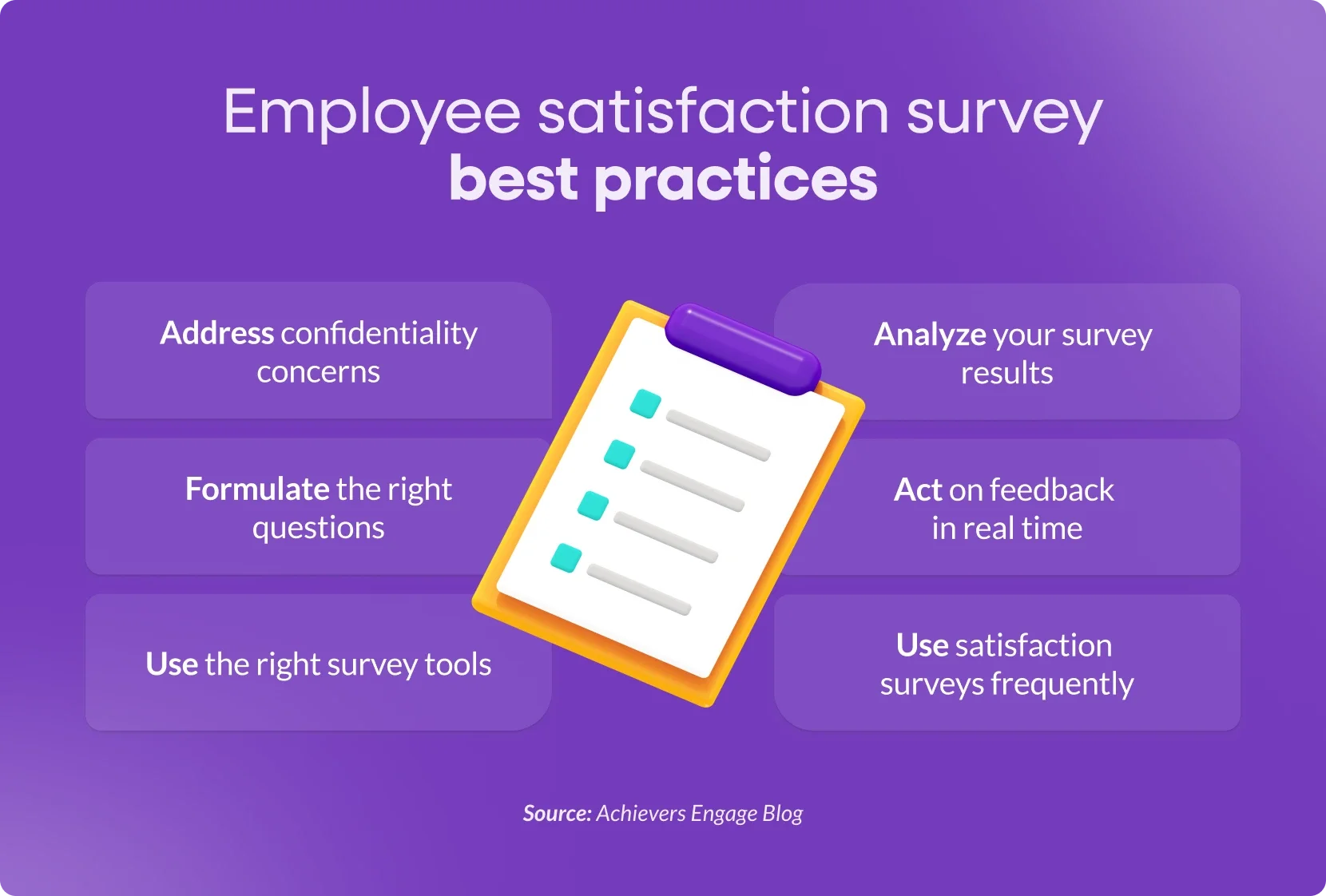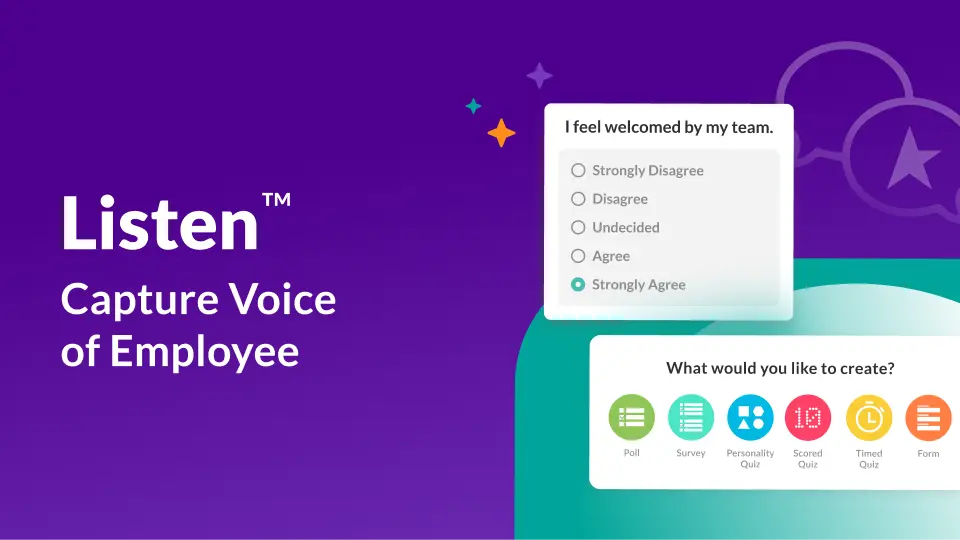Table of contents
Your employees spend a great deal of time at work, but do you know how they feel about the roles they play in your organization? When it comes to understanding what makes your employees tick or where they’re feeling disconnected, employee satisfaction surveys are designed to bridge that gap.
Employee satisfaction surveys are a valuable feedback tool that allows you to gauge how happy employees are in the workplace. They’re also an important part of their emotional salary — the non-monetary aspects of a job that contribute to feelings of engagement, well-being, and support. In fact, research from Achievers’ 2024 Engagement and Retention Report shows that 72% of employees say they would prefer a job where they feel supported and valued, compared to a job that paid 30% more but where they lacked that support.
But when it comes to gauging those metrics, it’s not enough to simply send out a questionnaire once a year or only engage with employees during performance reviews. Your employees need regular touch points where they can anonymously share their thoughts and offer insightful feedback. These insights can then help you shape company practices, ensuring you’re building a culture that’s sustainable long-term.
With the right questions and practices in place, business leaders can see first-hand how employees feel about various aspects of the organization, from feelings of belonging to management concerns and overall engagement.
What is an employee satisfaction survey?
Employee satisfaction surveys are more than a series of yes or no, true or false questions. They’re a thoughtful way for organizations to connect with their employees and learn how engaged and valued they feel in the workplace.
These surveys, whether they’re designed with open-ended or Likert-style questions, help employers learn how employees view their workload, their coworkers, management, and overall job satisfaction. With these new metrics, organizations can pinpoint what’s working well and where they might need to improve. This allows leadership to make quick, actionable changes and help create a more supportive and motivating atmosphere.
While employee engagement measures how committed and excited employees are about their company’s goals, employee satisfaction is more about how happy employees are with their jobs on a personal level. It’s important for companies to recognize the difference between the two and address both to create a balanced and growth-oriented workplace.
Understanding employee satisfaction surveys
Employee satisfaction refers to how happy or fulfilled employees are with their job. Employee satisfaction surveys consist of a series of questions that employees answer to reveal how they feel about their work environment. They’re designed to help you learn about your organization’s strengths and weaknesses and then act on this valuable feedback.
It’s important to note that employee satisfaction is not the same as employee engagement. While employee satisfaction shows the degree to which workers are happy with their jobs, employee engagement arises when employees are committed to helping their organizations fulfill their goals. While engaged employees may often be satisfied with their jobs — and vice versa — this isn’t always the case. For instance, a satisfied employee may enjoy their work, but they may not be motivated to put in extra hours or take on other tasks.
Employee satisfaction surveys are key to shaping initiatives that boost engagement at work, which, in turn, leads to higher employee retention and better business outcomes.
Why employee satisfaction surveys are valuable
If you ask your employees how satisfied they are at work directly, the answers you receive may not be accurate: 77% of respondents said they’re more likely to provide honest feedback when given a survey than when asked by their manager. This explains why there’s a huge disconnect between how leadership and HR perceive the employee experience and employees’ actual feelings. Obtaining honest feedback from your employees is essential for understanding how your workers perceive your organization and what you can do to improve employee satisfaction.
Failure to understand how satisfied your employees are can lead to productivity loss, lower profits, and high turnover rates. There’s also an established connection between employee and customer satisfaction, especially in industries that have high levels of customer contact. As dissatisfied employees are unhappy with their jobs, their poor attitudes and behaviors are likely to cause problems among customers and eventually result in revenue loss.
What can employee satisfaction surveys measure?
Employee satisfaction surveys should be used first and foremost to measure the major drivers of satisfaction. These include whether employees feel appreciated, their feelings on work-life balance, available opportunities for career growth, and relationships with management. They can also show you how team members feel about your company’s work environment and culture. Do they enjoy coming to work and interacting with managers and colleagues? Or do they feel tense and uneasy while on the job?
With employee satisfaction surveys, you can measure both quantitative and qualitative data, from response rates to employee comments. You can use this data to gain an in-depth understanding of your organization’s strengths and weaknesses, preferably with a voice of the employee solution that offers a heat map of areas related to employee satisfaction and an action builder for creating collaborative plans to address feedback together with your team.

30 employee satisfaction survey questions
What questions should you include in your employee satisfaction survey? Here are 30 examples that touch on some of the most important drivers of employee satisfaction.
Recognition
1. Are you recognized by leadership for your hard work?
2. How often do you receive positive feedback for your work?
3. Do you feel that your manager values your contributions on the job?
4. Is recognition distributed fairly across the team?
5. Are you encouraged to recognize your peers?
It’s human nature for employees to want recognition for the work they perform for your company day in and day out. When your employees feel appreciated, they’re more likely to stay with your organization and perform better. In fact, 87% of employees who receive at least monthly recognition say they’re more productive at work.
While recognition comes in many forms, insights from Forbes show employees who receive regular recognition from their managers and coworkers are 56% less likely to look for jobs elsewhere and five times more likely to see opportunities for growth in their current organization.
Culture and values
1. Are you inspired by our company’s mission and values?
2. Do you think our company has a healthy culture?
3. Is diversity and inclusion a priority in your workplace?
4. How well does the company support work-life balance?
5. Do you feel the company values employee well-being beyond work performance?
At its core, organizational culture is the set of shared values, goals, and practices that guide everyone at your company. Your employees need to relate to your culture and have positive feelings about it, because culture alignment is one of the primary ways to increase employees’ emotional salary, according to Achievers 2024 Engagement and Retention Report. And those benefits carry over to your organization’s retention capabilities: companies with strong culture alignment are nine times more likely to have high job commitment, compared to those who lack this type of foundation.
To get employees to buy into your culture and company values, start with leadership. Your leaders should serve as examples to the rest of your workforce by consistently acting in line with the culture you want to build. You should also weave company’s values into every part of the business, from HR policies to benefits programsf. Team building activities are another great way to foster an exceptional company culture, even when your team is mostly or fully remote.
Career opportunities
1. Do you believe there are opportunities to grow your career within our company?
2. Are you likely to search for another job at a different organization?
3. Are your skills effectively used in your current role?
4. Do you receive guidance on how to achieve your career goals?
5. Is there a transparent process for career advancement in the company?
Most employees take a job with the hopes that they’ll be able to work their way up to a higher-level position, more responsibilities, and, of course, increased pay. Employees who feel stuck in their role and don’t see any room for advancement will show their dissatisfaction by searching for a new job where they can achieve their professional goals. According to LinkedIn, career development is so important to job seekers that nine out of 10 want to see a skills development program, direct career paths, and career advancement opportunities when they’re considering a new job.
For these reasons, your organization needs to show employees that there are opportunities for growth. Establish sensible career paths and clear criteria for advancement along them. You can also empower employees by giving them new responsibilities and more autonomy, which shows that you trust them to succeed. Paying for them to learn new skills by covering the cost of new certifications, offering tuition reimbursement, or paying for trips to useful classes and seminars are all great ways to show investment in your employees as well.
Leadership
1. Does leadership offer opportunities to learn new skills and grow within the organization?
2. Do you trust the leadership team’s decisions?
3. Do you feel senior leadership communicates company news in an effective, timely manner?
4. How well does leadership handle conflict or difficult situations?
5. Does leadership connect with employees beyond performance reviews?
The importance of leadership within your company should not be overlooked. If employees are motivated by leaders and perceive them to genuinely value their hard work, they’re likely to feel satisfied at your company. On the other hand, employees who believe leadership does a poor job listening to them or appear to be disinterested in their success may look elsewhere for employment.
Communication
1. How comfortable are you with providing honest feedback?
2. Do you think your manager listens to you and acts on your feedback?
3. Are the company’s expectations for your role clear?
4. Do you feel there is transparency in decision-making at the company?
5. How well does cross-department communications work in the organization?
Strong communication is an important tool for a healthy employee-employer relationship. Companies that communicate well are more likely to perform highly than those who struggle with communication. And it doesn’t stop with performance. According to Forbes, 89% of HR leaders say that ongoing feedback and check-ins are key for successful business outcomes.
When employees feel like they can openly communicate with their managers and colleagues, there’s a higher chance they’ll be satisfied at work. They want to work with those who will appreciate their honesty and be honest with them in return.
While communication is always important, it’s particularly crucial in remote workplaces where employees may not see their team members in person. Meaningful communication allows them to feel connected to their workplace and the individuals they collaborate with on a regular basis.
Health and wellness
1. Do you feel you have a healthy work-life balance?
2. Do you believe our company offers adequate health and wellness benefits?
3. Do you feel encouraged to prioritize your physical and mental health?
4. Do you have access to stress management or wellness programs?
5. How comfortable are you discussing wellness challenges with your manager or HR?
A poor work-life balance can lead to a variety of problems. Not only can it hinder the health of your employees, but it can also create issues with engagement and productivity. Employees who are burnt out won’t be able to perform well and can therefore hurt, rather than help your bottom line. In fact, 72% of employees said that having more work benefits would increase their satisfaction.
That’s why it’s imperative that you take their health and wellness seriously. By encouraging paid time off (PTO), embracing flex time, and promoting efficiency, you can help your employees achieve a healthy work-life balance that benefits everyone involved. You can also provide paid gym memberships and healthy snacks or lunches, which will help your team stay engaged, productive, and satisfied.

Employee satisfaction survey best practices
When done right, employee satisfaction surveys offer valuable insights and metrics that can help drive positive change in your organization. But to get the most out of them, it’s important to follow some key best practices. Here are some important steps to ensure your surveys are effective, actionable, and reflect your employees’ experiences.
Use the right survey tools
How you listen to your employees is just as important as how often you engage. The right tools can help you collect meaningful data that helps contribute to a more well-rounded view of your organization as it stands. It’s important for your survey tools to be customizable, easy to navigate, and able to examine results effectively. Not only does this save time on the leadership side, but it also streamlines the employee survey experience for the users themselves.
Features like pulse surveys, Likert scales, and open-ended questions allow employees to express their feelings and concerns in a way that’s both qualitative and quantitative. This flexibility gives employers the data they need to figure out how employees feel about their workload, help identify trends, discover areas for improvement, and take action based on real, honest feedback.
Formulate the right questions
If you want to know how your employees feel about certain areas of the organization, you need to know the right survey questions to ask. When creating these regular check-ins, it’s important to design your questions in a way that authentically captures how they feel about their workplace.
If you’re surveying new employees, consider creating questions where they can discuss how they felt about their onboarding process. If you’re looking for everyday insights, asking how your employees feel about their workload, whether they’re excited to come into work, or if they find their work meaningful can help offer a holistic view. The right open-ended questions can also help managers identify where they could improve or where they could best support their employees.
At the end of the day, thoughtful questions produce thoughtful answers. By tailoring questions to reflect the type of metrics you’re looking for, your employee survey questions can help you figure out what is and isn’t working in your organization.
Address confidentiality concerns
Your employees need a safe environment where they can be transparent without fear of consequences. Without this, you may receive biased answers or feedback that doesn’t accurately reflect the current state of employee satisfaction.
When creating an employee survey, it’s important to communicate from the beginning that responses will remain anonymous and explain how data will be used. Using a trusted listening tool that promises anonymity, without collecting any identifying information, will help instill trust in your leadership and open the door for honest feedback.
It’s also important to communicate how survey results will be handled and who will have access to the data. Employees should be able to confidently identify who will be collecting their answers and how they’ll be used to improve organizational culture and overall satisfaction.
Analyze survey results
Employee satisfaction surveys won’t do you any good unless you analyze their results. Once they’ve been filled out, take a close look at your employees’ answers. Consider comments and response rates. Use heat maps to find out where your organization shines as well as areas where you can improve. The goal is to use your employee satisfaction surveys as valuable tools that allow you to increase the number of employees that are satisfied as well as raise the overall level of satisfaction.
It’s important to remember that response rates will vary based on the size of your company. Response rates should vary between 80% to 90% for organizations with less than 50 employees, 70% to 80% for those with a few hundred employees, and 65% to 80% for companies with 1,000 or more.
Act on feedback in real time
It’s no surprise to learn that the best way to build employee trust is not only to provide regular feedback, but to act on their concerns. And the longer you wait, the more dissatisfied your employees will become. Taking action can transform your culture and prevent minor issues from turning into major problems.
As soon as managers gather employee feedback and understand what needs to be done to support the organization’s employee satisfaction goals, it’s time to put a plan in motion. Every manager should meet with their team, share survey results, and collaboratively develop an action plan together. They can also answer any questions that may arise and address employee concerns.
Use surveys frequently
Even though you may have a lot on your plate, it’s in your best interest to produce employee satisfaction surveys often. An annual survey won’t provide you with accurate information, as the state of employee satisfaction is constantly evolving. Gathering a large amount of data all at once is just as inefficient, and it makes it difficult to turn that information into actionable insights.
Instead of sending out a survey once a year, opt for a continuous listening approach where you collect survey responses from employees on an ongoing basis. You’re more likely to understand how satisfied your employees are when you have recent, accurate feedback and data to back it up.
Employee satisfaction survey software
When it comes to recognizing and valuing your employees, you don’t need to try and read their mind. All you need a software that listens and analyzes in real time.
Achievers is helping organizations build better workplace culture through data-driven feedback tools including our employee satisfaction surveys. Our software offers a solution that makes collecting employe feedback regularly simple and straightforward. With a user-friendly interface and intuitive metrics, we help organizations collect valuable insights on all areas of workplace satisfaction from employee onboarding to well-being check-ins, and management feedback.
“Achievers has impacted engagement at ATB by giving our team members a platform to share their voice and seek and share feedback amongst each other, to come together as one ATB in a visual way.” — Kelsey Schneider, Financial Recognition and Rewards Lead, ATB
We know that asking the right questions is the best way to learn what your organization is doing well and where your employees want to see improvement. By using features like pulse surveys, lifecycle surveys, and always-on feedback channels, you have the tools you need to keep your finger on the pulse.
Plus, Achievers Listen also integrates seamlessly into existing HR systems, making it convenient for organizations to implement without disrupting current workflows. Through Achievers, companies can enhance their strategies for increasing employee satisfaction, which can lead to increased retention rates and a more engaged and productive workforce.
Start surveying your employees today
While employee satisfaction surveys are useful, they only address one piece of the employee engagement puzzle. To keep your employees both happy and motivated, it’s wise to invest in a voice of the employee solution like Achievers Listen. With pulse surveys, lifecycle surveys, an always-on AI chatbot, and ad hoc surveying capabilities, it has everything your organization needs to make smart decisions that lead to more engaged and satisfied employees, greater productivity, and unparalleled success.



